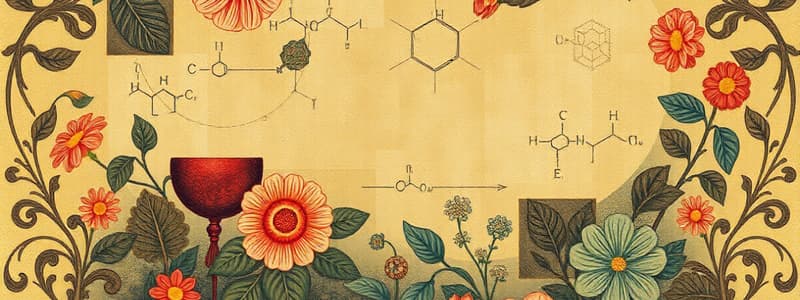Podcast
Questions and Answers
What technique is primarily used to identify functional groups in organic compounds?
What technique is primarily used to identify functional groups in organic compounds?
- Infrared Spectroscopy (correct)
- Nuclear Magnetic Resonance Spectroscopy
- Mass Spectrometry
- Chemical Chromatography
Which of the following correctly describes aromatic compounds?
Which of the following correctly describes aromatic compounds?
- Compounds containing alternating double bonds without a benzene ring
- Compounds that can only exist in a gas state
- Compounds with only carbon atoms in their structure
- Compounds with a benzene ring that exhibit unique stability (correct)
Which term refers to large molecules made up of repeating structural units?
Which term refers to large molecules made up of repeating structural units?
- Dimers
- Oligomers
- Polymers (correct)
- Monomers
What information does Nuclear Magnetic Resonance (NMR) Spectroscopy provide?
What information does Nuclear Magnetic Resonance (NMR) Spectroscopy provide?
Which hydrocarbon is NOT an aromatic compound?
Which hydrocarbon is NOT an aromatic compound?
What distinguishes organic chemistry from inorganic chemistry?
What distinguishes organic chemistry from inorganic chemistry?
Which reaction type involves the loss of atoms or groups from a molecule?
Which reaction type involves the loss of atoms or groups from a molecule?
What is the characteristic of structural isomers?
What is the characteristic of structural isomers?
Which functional group is characterized by a -COOH structure?
Which functional group is characterized by a -COOH structure?
What is the general formula for alkynes?
What is the general formula for alkynes?
Which description best fits geometric isomers?
Which description best fits geometric isomers?
What is the main feature of alkanes that affects their reactivity?
What is the main feature of alkanes that affects their reactivity?
Which of the following best defines stereochemistry?
Which of the following best defines stereochemistry?
Flashcards
Organic Chemistry
Organic Chemistry
The branch of chemistry dealing with carbon-containing compounds.
Functional Groups
Functional Groups
Specific groups of atoms within molecules that dictate their chemical reactions.
Isomers
Isomers
Molecules with the same molecular formula but different structures.
Alkanes
Alkanes
Signup and view all the flashcards
Alkenes
Alkenes
Signup and view all the flashcards
Alkynes
Alkynes
Signup and view all the flashcards
Substitution Reaction
Substitution Reaction
Signup and view all the flashcards
Stereochemistry
Stereochemistry
Signup and view all the flashcards
Hydrocarbons
Hydrocarbons
Signup and view all the flashcards
Organic Spectroscopy
Organic Spectroscopy
Signup and view all the flashcards
Polymers
Polymers
Signup and view all the flashcards
Aromatic Compounds
Aromatic Compounds
Signup and view all the flashcards
IR Spectroscopy
IR Spectroscopy
Signup and view all the flashcards
Study Notes
-
Organic chemistry is the study of carbon-containing compounds, excluding simple carbonates, cyanides, and oxides of carbon.
-
Carbon's unique ability to form four covalent bonds allows for the creation of a vast array of complex molecules.
Types of Organic Reactions
-
Substitution: One atom or group is replaced by another.
-
Addition: Two molecules combine to form a single molecule.
-
Elimination: A molecule loses atoms or groups of atoms, forming a double or triple bond.
-
Rearrangement: Atoms or groups within a molecule are reorganized without changing the overall composition.
Functional Groups
-
Functional groups are specific groups of atoms within molecules that are responsible for most of the characteristic chemical reactions of those molecules. Understanding these groups is crucial for predicting how compounds will behave.
-
Common functional groups include:
- Alkanes (single bonds only)
- Alkenes (carbon-carbon double bonds)
- Alkynes (carbon-carbon triple bonds)
- Alcohols (-OH group)
- Aldehydes (-CHO group)
- Ketones (C=O group, with carbons on either side)
- Carboxylic acids (-COOH group)
- Amines (contain nitrogen atoms).
Isomerism
-
Isomers are molecules with the same molecular formula but different structures.
-
Structural isomers differ in the arrangement of atoms.
-
Stereoisomers have the same atom connectivity but different spatial arrangements.
- Geometric isomers (cis-trans) differ in the arrangement around a double bond.
- Enantiomers are non-superimposable mirror images.
Alkanes
-
Saturated hydrocarbons (only single bonds).
-
General formula: CnH2n+2
-
Relatively unreactive due to strong C-C and C-H bonds.
Alkenes
-
Unsaturated hydrocarbons (contain at least one carbon-carbon double bond).
-
More reactive than alkanes due to the presence of the double bond.
-
Geometric isomers are possible due to restricted rotation around the double bond.
-
General formula: CnH2n
Alkynes
-
Unsaturated hydrocarbons (contain at least one carbon-carbon triple bond).
-
Even more reactive than alkenes.
-
General formula: CnH2n-2
Naming Organic Compounds
- Systematic nomenclature is used to avoid confusion. Rules specify prefixes, suffixes, and numbers for identifying the position of substituents (branches).
Stereochemistry
- The three-dimensional arrangement of atoms in a molecule. Critically important for biological activity.
Hydrocarbons
- Compounds consisting of only carbon and hydrogen. Form the backbone of many organic molecules.
Organic Spectroscopy
- Used to determine the structure of organic molecules. Techniques include:
- Infrared (IR) Spectroscopy: Identifies functional groups by the absorption of infrared light.
- Nuclear Magnetic Resonance (NMR) Spectroscopy: Provides information about the environment of hydrogen atoms in a molecule, allowing for structural elucidation.
- Mass Spectrometry: Provides information about the molecular weight and fragmentation patterns of a molecule.
Polymers
-
Large molecules composed of repeating structural units.
-
Examples include plastics, natural rubber, and proteins.
Aromatic Compounds
-
Compounds containing benzene rings (or similar structures).
-
Exhibit unique stability due to delocalized electrons in the ring.
-
Benzene, toluene, and naphthalene are examples.
-
Important in many industrial processes.
Studying That Suits You
Use AI to generate personalized quizzes and flashcards to suit your learning preferences.




